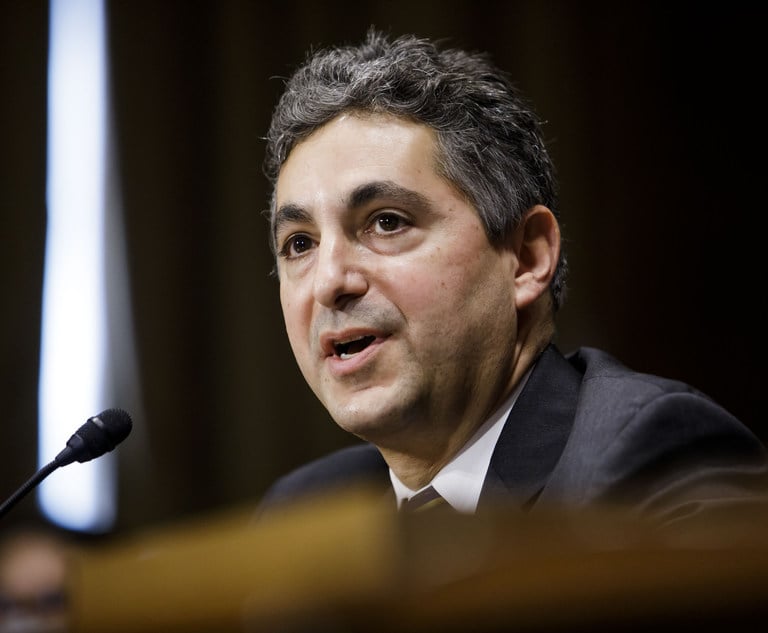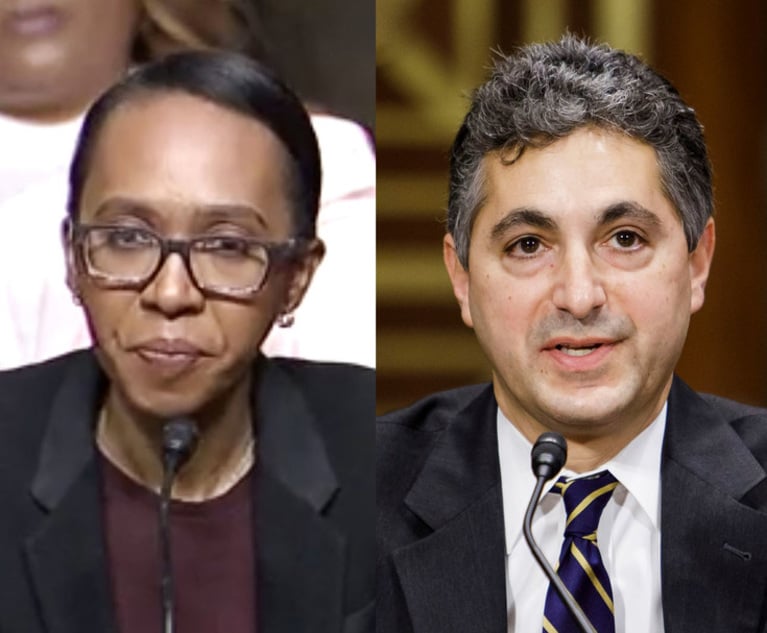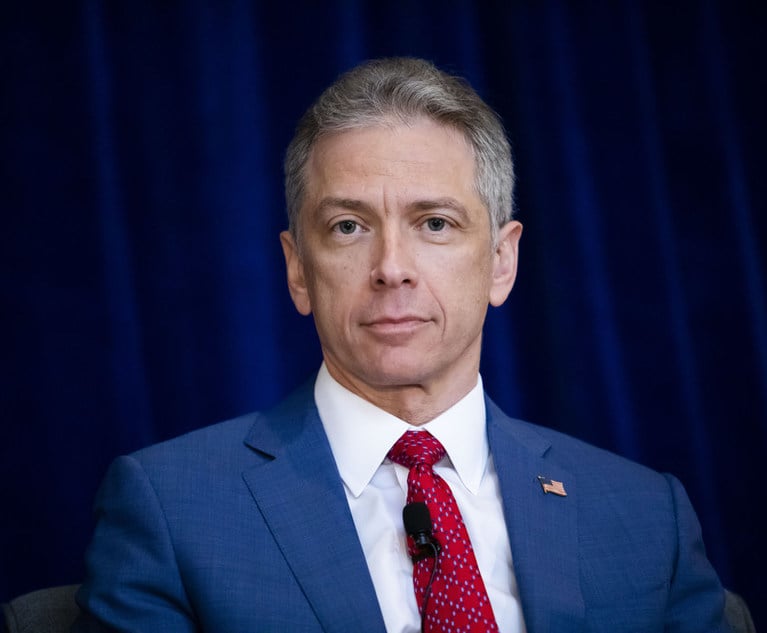Skilled in the Art: The Revolution Will Not Be on Pleading Paper
A San Francisco judge is encouraging attorneys to file briefs on plain paper. Two IP lawyers were the first to take him up on it.
October 19, 2018 at 07:50 PM
8 minute read
Welcome to Skilled in the Art. I'm Law.com IP reporter Scott Graham. It's the little things in life and the law that count, right? Like the kind of paper you file your briefs on. A Northern District of California judge is trying to show through his standing order that the world won't end if counsel don't use formal pleading paper. Two IP lawyers are the first to take him up on his challenge. I've also got news of a possible course correction on motions to transfer at the Federal Circuit, expansion plans at Desmarais LLP, and more. As always feel free to email me your thoughts and feedback and follow me on Twitter.
➤➤ Would you like to receive Skilled in the Art by email? Sign up here.
 U.S. District Judge Vince Chhabria.
U.S. District Judge Vince Chhabria.
The Revolution Will Not Be on Pleading Paper
U.S. District Judge Vince Chhabria was in a sunny mood when cloud communication companies Telesign and Twilio squared off over a Section 101 motion last September.
“I'm generally not a big fan of patent cases,” Chhabria said, but “I found myself really enjoying reading the briefs. Can anybody guess why?”
“I assume it's because we've learned to write very well, and it reads like a novel,” Twilio attorney Wayne Stacy offered, to laughter in the courtroom.
That wasn't the reason, though the briefs were very good, Chabbria said. Instead it's because Stacy, a partner at Baker Botts, and Telesign counsel Jesse Camacho of Shook, Hardy & Bacon had filed them on plain paper—not the traditional lined and numbered pleading paper.
Chhabria recently declared his preference for plain paper in his civil standing order, and Stacy and Camacho were the first to take him up on it.
“I mean, this is the 21st Century. I don't understand why our court still requires briefs to be filed on pleading paper,” Chhabria said, according to a transcript of the Sept. 20 hearing. In his 19-year career as a judge, lawyer and law clerk, “never once did I identify an instance in which pleading paper was helpful,” Chhabria said. Rather, it “clutters the page, it makes the brief or the order more difficult to read.”
The judge asked the two lawyers if they've ever found pleading paper helpful.
“Not once,” Stacy answered.
Camacho hedged slightly. “The only time is if I wanted to pinpoint a specific line to aid the court,” he said.
But how hard is it to say “look at the second full paragraph of page 3, third line down?” Chhabria asked.
“It's not,” Camacho quickly agreed.
Stacy said this week that pleading paper is no big deal for large law firms like his that have data processing departments. But for a smaller firm or a solo, finding and complying with the right template “can be a big headache” and end up costing a client money. Some other courts he's appeared in have moved on beyond pleading paper, he said.
As for the hearing before Chhabria, Stacy had two takeaways: “Read the standing order, and try to make things easier for people.”
ED-Tex's Rocket Docket Worthy of 'Some Consideration' on Transfers
It's been a tough few years for the Eastern District of Texas and the patent owners who want to litigate there. In addition to the Supreme Court's TC Heartland decision tightening venue standards, the Federal Circuit has also periodically overruled the refusal to transfer cases out of the district on convenience grounds. Dennis Crouch suggested last month that it might be time to rethink the convenience line of cases.
It now looks as if the Federal Circuit has taken one small step toward doing so. On Tuesday the court refused to second-guess U.S. District Judge Rodney Gilstrap's decision to hold onto a patent suit against Apple, rather than transfer it to Apple's home turf in the Northern District of California.
Apple can't really argue that venue is improper in the Eastern District, so long as it maintains places of business there. But it can and did argue that venue is inconvenient in In re Apple. The company accused patent owner AGIS Software of manufacturing venue in the Eastern District by simply renting office space there a month before filing suit.
Gilstrap found that AGIS' CEO and his family have owned property in the district for years—and that the median time to trial in the Eastern District of Texas is shorter than in ND-Cal. On balance, Gilstrap found Apple had not made a persuasive case for transfer.
Judge Alan Lourie wrote for a three-judge Federal Circuit panel Tuesday that Gilstrap did not abuse his discretion. “The district court could fairly find that a shorter time to trial in its district was worthy of some consideration here,” Lourie wrote in a non-precedential order.
AGIS attorney Fred Fabricant of Brown Rudnick said in a written statement it's clear the Federal Circuit is going to extend district judges some latitude on convenience transfers. The appellate court isn't going to give “big corporate defendants with unlimited capital the routine ability to force transfer of the cases to the districts they prefer.”
Desmarais Expanding on Two Fronts
When Fitzpatrick, Cella, Harper & Scinto announced its upcoming merger with Venable, it raised the age-old question: Is the IP boutique model broken?
At least one boutique is thriving (and no doubt others). After launching with eight lawyers in 2010, Desmarais LLP now stands at 57 attorneys. The firm is gearing up its life science practice with the addition of partners Bindu Donovan and Todd Krause this week from Sidley Austin.
And in December, the New York-based firm is going to launch a San Francisco office. Founding partner John Desmarais, who will split time between the two locations, said the goal is to establish a local presence for tech clients such as Apple, Cisco Systems and Intel.
Desmarais said the office also should help the firm's recruiting pitch. “All of the talent coming out of Stanford and Berkeley, it's so strong,” he said. Often those graduates “like to stay in the area.”
Slick Win for Weil Gotshal
I learn something new every week writing about IP law. This week's nugget is that there's a product that makes oil more slippery.
And not just any product. LiquidPower Specialty Products claims that its ExtremePower drag-reducing polymer solved a long-felt need in the energy industry. The product helps transport heavy crude through pipelines without having to heat or dilute the oil, or add pumping stations.
The Patent Trial and Appeal Board invalidated LiquidPower's 8,022,128 patenton this polymer as obvious, based in part on a 1991 patent owned by petitioner Baker Hughes. If the 1991 patent had made the polymer so obvious, “Baker would not have failed to solve the long-felt need for a DRA polymer that would work in heavy crude for so long,” Weil Gotshal & Manges partner Ed Reinesargued to the Federal Circuit.
On Thursday the appellate court agreed that there is at least a nexus of evidence tying ExtremePower's commercial success to the claimed features of the '118 patent. Judge Kimberly Moore's unanimous decision sends the case back to the PTAB. “On remand, it is up to the board to consider the amount of weight to give to this evidence,” she wrote.
And a Heart Stopper for Latham
Collecting and analyzing information—even if it's potentially life-saving information—is still an abstract idea unworthy of patent protection. At least it was this week in U.S. District Judge Indira Talwani's court.
Talwani ruled that a patent directed to an automated process for identifying atrial fibrillation and flutter, and distinguishing them from more benign forms of cardiac arrhythmia, is ineligible under Section 101. It's the sixth out of seven asserted patents that startup InfoBionic has invalidated in a patent fight with heart monitoring incumbent CardioNet.
InfoBionic, represented by Latham & Watkins, markets the MoMe Kardiaheart monitoring device. CardioNet, backed by Sidley Austin, has brought two separate complaints for infringement. Talwani has now ruled three of CardioNet's patents ineligible, while the Patent Trial and Appeal Board has invalidated three others.
Tuesday's decision addressed U.S. patent 7,941,207, which describes systems and methods for analyzing in real time the variability in timing between heartbeats, taking into account ventricular beats, and alerting the user of any atrial fibrillation or flutter, known collectively as AF.
CardioNet argued that's a concrete improvement to the function of cardiac monitoring devices. InfoBionic responded that the patent simply automates the traditional methods doctors use for identifying AF, without claiming a specific implementation.
Talwani sided with InfoBionic. “The idea of using a machine to monitor and analyze heart beat variability and interfering beats so as to alert the user of potential AF events may well improve the field of cardiac telemetry, but plaintiffs do not identify improvements to any particular computerized technology,” she wrote.
Latham's team for InfoBionics includes partners Charles Sanders, Max Grant and Gabriel Bell and associate Abigail Amato Rives. They're not out of the woods yet. The seventh patent asserted by CardioNet remains live, and the parties are still thrashing out claim construction issues.
That's all I've got this week. Skilled in the Art will be on hiatus next week while I grab some vacation. I'll see you all again on Tuesday, Oct. 30.
This content has been archived. It is available through our partners, LexisNexis® and Bloomberg Law.
To view this content, please continue to their sites.
Not a Lexis Subscriber?
Subscribe Now
Not a Bloomberg Law Subscriber?
Subscribe Now
NOT FOR REPRINT
© 2025 ALM Global, LLC, All Rights Reserved. Request academic re-use from www.copyright.com. All other uses, submit a request to [email protected]. For more information visit Asset & Logo Licensing.
You Might Like
View All
Skilled in the Art With Scott Graham: I'm So Glad We Had This Time Together

Design Patent Appeal Splinters Federal Circuit Panel + Susman Scores $163M Jury Verdict + Finnegan Protects Under Armour's House
Trending Stories
- 1No Two Wildfires Alike: Lawyers Take Different Legal Strategies in California
- 2Poop-Themed Dog Toy OK as Parody, but Still Tarnished Jack Daniel’s Brand, Court Says
- 3Meet the New President of NY's Association of Trial Court Jurists
- 4Lawyers' Phones Are Ringing: What Should Employers Do If ICE Raids Their Business?
- 5Freshfields Hires Ex-SEC Corporate Finance Director in Silicon Valley
Who Got The Work
J. Brugh Lower of Gibbons has entered an appearance for industrial equipment supplier Devco Corporation in a pending trademark infringement lawsuit. The suit, accusing the defendant of selling knock-off Graco products, was filed Dec. 18 in New Jersey District Court by Rivkin Radler on behalf of Graco Inc. and Graco Minnesota. The case, assigned to U.S. District Judge Zahid N. Quraishi, is 3:24-cv-11294, Graco Inc. et al v. Devco Corporation.
Who Got The Work
Rebecca Maller-Stein and Kent A. Yalowitz of Arnold & Porter Kaye Scholer have entered their appearances for Hanaco Venture Capital and its executives, Lior Prosor and David Frankel, in a pending securities lawsuit. The action, filed on Dec. 24 in New York Southern District Court by Zell, Aron & Co. on behalf of Goldeneye Advisors, accuses the defendants of negligently and fraudulently managing the plaintiff's $1 million investment. The case, assigned to U.S. District Judge Vernon S. Broderick, is 1:24-cv-09918, Goldeneye Advisors, LLC v. Hanaco Venture Capital, Ltd. et al.
Who Got The Work
Attorneys from A&O Shearman has stepped in as defense counsel for Toronto-Dominion Bank and other defendants in a pending securities class action. The suit, filed Dec. 11 in New York Southern District Court by Bleichmar Fonti & Auld, accuses the defendants of concealing the bank's 'pervasive' deficiencies in regards to its compliance with the Bank Secrecy Act and the quality of its anti-money laundering controls. The case, assigned to U.S. District Judge Arun Subramanian, is 1:24-cv-09445, Gonzalez v. The Toronto-Dominion Bank et al.
Who Got The Work
Crown Castle International, a Pennsylvania company providing shared communications infrastructure, has turned to Luke D. Wolf of Gordon Rees Scully Mansukhani to fend off a pending breach-of-contract lawsuit. The court action, filed Nov. 25 in Michigan Eastern District Court by Hooper Hathaway PC on behalf of The Town Residences LLC, accuses Crown Castle of failing to transfer approximately $30,000 in utility payments from T-Mobile in breach of a roof-top lease and assignment agreement. The case, assigned to U.S. District Judge Susan K. Declercq, is 2:24-cv-13131, The Town Residences LLC v. T-Mobile US, Inc. et al.
Who Got The Work
Wilfred P. Coronato and Daniel M. Schwartz of McCarter & English have stepped in as defense counsel to Electrolux Home Products Inc. in a pending product liability lawsuit. The court action, filed Nov. 26 in New York Eastern District Court by Poulos Lopiccolo PC and Nagel Rice LLP on behalf of David Stern, alleges that the defendant's refrigerators’ drawers and shelving repeatedly break and fall apart within months after purchase. The case, assigned to U.S. District Judge Joan M. Azrack, is 2:24-cv-08204, Stern v. Electrolux Home Products, Inc.
Featured Firms
Law Offices of Gary Martin Hays & Associates, P.C.
(470) 294-1674
Law Offices of Mark E. Salomone
(857) 444-6468
Smith & Hassler
(713) 739-1250










